1962 German Grand Prix race report: Hill the rain meister at the Nordschleife
Just four seconds covers the top three finishers as Graham Hill pips, John Surtees and Dan Gurney
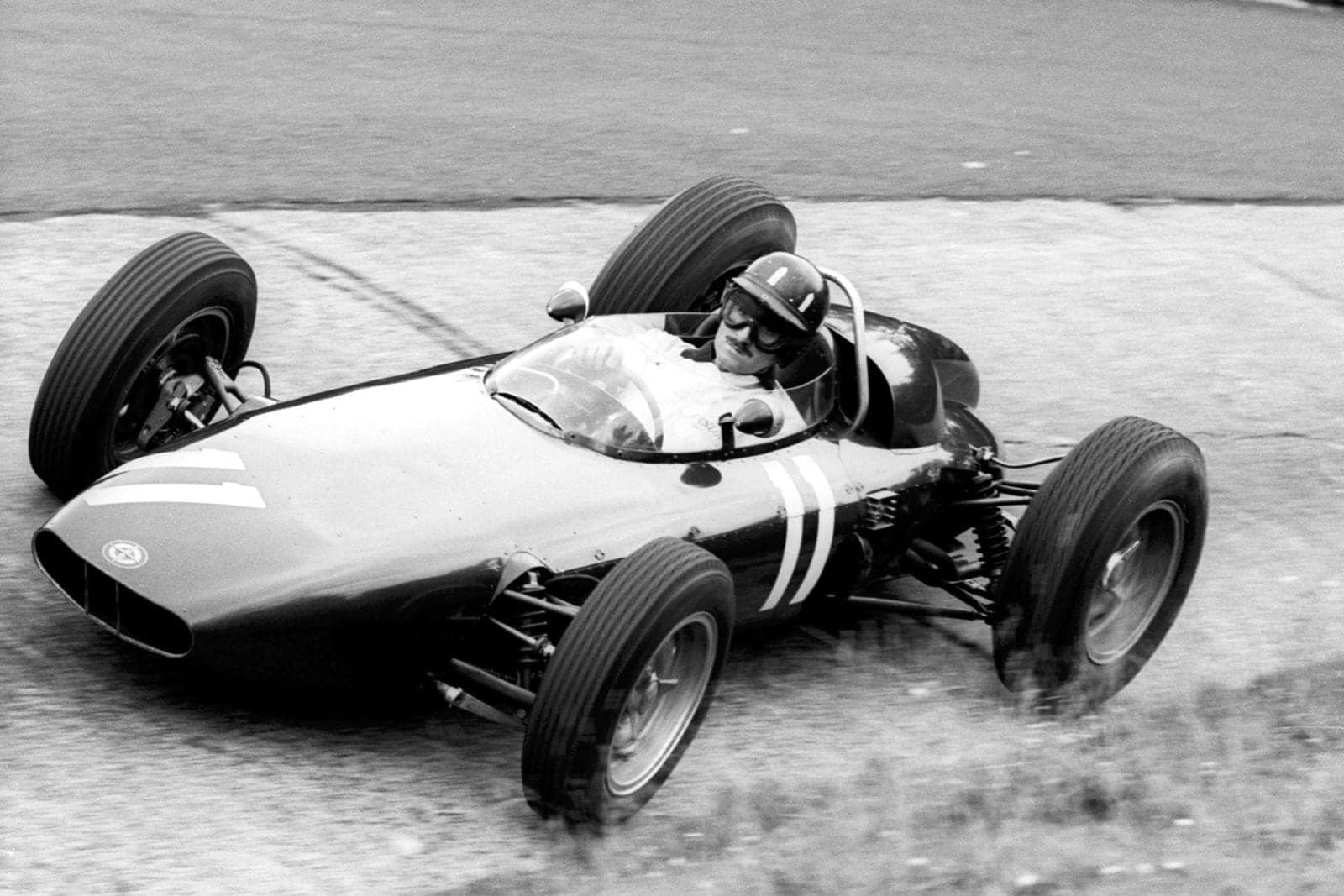
Hill put in a masterful performance in his BRM to win
Motorsport Images
The Automobile Club von Deutschland collected a vast entry for the German Grand Prix at the Nürburgring, including all the factory teams and nearly all the private-owners, the only notable exception being the UDT-Laystall team. It seemed that the AvD did not want to know about Mr Ken Gregory and his pale green cars, but they would have liked his drivers, Ireland and Masten Gregory.
The Grand Prix scene is certainly still full of interest for at this meeting there were three brand new designs of Grand Prix car, as described elsewhere in this issue. These were the new Ferrari, which was lighter and lower, the new Brabham car, designed by Ron Tauranac and Jack Brabham, and the new Gilby-BRM designed by Len Terry and built by Gilby Engineering.
The Scuderia Ferrari were out in full force, having partially recovered from strikes, newshounds and story-tellers, or possibly because Enzo Ferrari likes the Nürburgring and can talk business with the Germans. They had four cars and four drivers, the leader, Phil Hill, having the car he raced at Aintree with the 6-speed gearbox ahead of the rear axle and the clutch behind it. Baghetti had a very ordinary car with 120-degree engine unit, as used in earlier races this year, and Rodriguez had an even earlier model with 65-degree V6 engine, which was in fact a 1961 car. When he heard he was to drive this old model he was none too pleased, which may have accounted for his subsequent brilliant performances which completely spoilt any technical statistics. The fourth driver was Bandini and he was given the brand new car, making its first appearance.
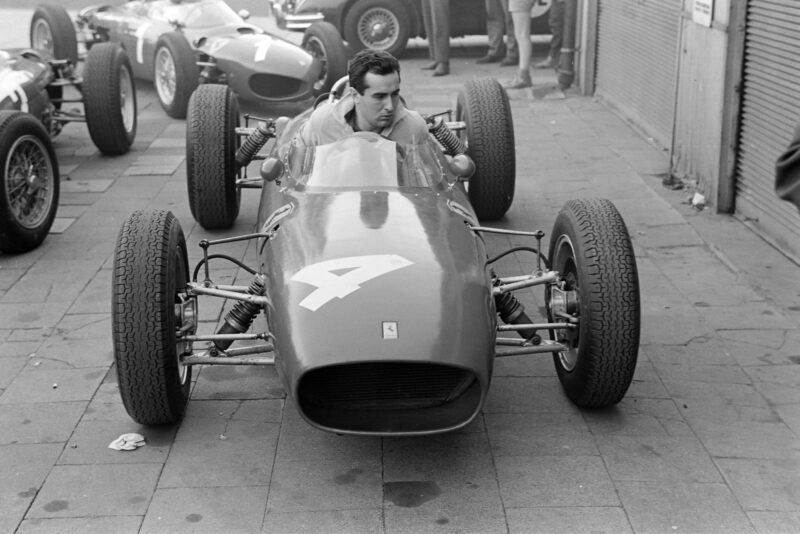
Bandini brings his Ferrari into the paddock
Motorsport Images
Next on the list came the two Team Lotus entries of Clark with the Lotus 25 and Taylor with the Lotus 24, as raced at Aintree. Gurney and Bonnier were in the flat-8-cylinder Porsches, Gurney having the newest one, while there was a third car as spare. The Cooper team of McLaren and Maggs had the two Climax V8 Cooper cars, and they had CT Atkins’ 4-cylinder car with them as a spare. BRM had the three cars they had at Aintree, the spare one being the latest one that had only been used for practice previously, and Graham Hill and Ginther were the drivers.
The Lola team also had their three cars entered by Bowmaker, Surtees having the choice of the brand new one that practised at Aintree or the one he’d been using all season, while Salvadori was keeping to his usual car. The new Lola had been fitted with a 5-speed Colotti gearbox in place of its original 6-speed, as there was enough to do to sort out the new chassis without having the complication of a new gearbox as well.
Jack Brabham at last made a public appearance with the long awaited Brabham-Climax V8, which is described in detail elsewhere, and he was using a 6-speed Colotti gearbox. The Rob Walker team had yet again completely rebuilt their Lotus 24 with Climax V8 engine, using a new chassis and suspension after the Rouen crash, and Trintignant was once more trying his luck. The Dutchman de Beaufort had had his Porsche painted a smart orange at long last, as well as having its usual mechanical overhaul after each race, and Lewis had his Cooper-Climax 4-cylinder now looking a bit “used.”
The Swiss Ecurie Filipinetti entered three runners, these being Siffert with their 4-cylinder Lotus-Climax, Heinz Schiller with their new Lotus-BRM V8 car, and hill-climb expert Heini Walter in Schiller’s 4-cylinder Porsche. The SSS Venezia team had one entry, this being Vaccarella with their 4-cylinder Porsche, and Keith Greene had his new Gilby-BRM V8 with 6-speed Colotti gearbox, described in detail elsewhere. The rest of the field comprised Burgess with the Anglo-American team Cooper-Climax 4-cylinder, Bianchi with the Maserati-engined ENB, Chamberlain with his old Lotus 18, Shelly with Dalton’s Lotus 18, Collomb with his ex-Surtees Cooper-Climax 4-cylinder and Seidel with his Lotus-BRM V8. There was one non-starter for practice, this being AE Marsh whose BRM V8 is still not raceworthy, but that is a long story.
“In view of the arduousness of the Nürburgring and the notorious bad weather in the Eifel mountains, the practice allowed for the Grand Prix cars was hopelessly insufficient”
In view of the arduousness of the Nürburgring and the notorious bad weather in the Eifel mountains, the practice allowed for the Grand Prix cars was hopelessly insufficient. Too much time was taken up by supporting events such as practice for GT racing, saloon car racing, Go-Kart racing and demonstrations. On Friday there was an hour-and-a-half practice in the morning and an hour-and-a-quarter in the afternoon, the two sessions being too close together to allow much in the way of alterations or repairs.
On Saturday there was only one session of practice of an hour-and-a-quarter. If all goes well with your Grand Prix car this amount of time is probably just sufficient but the slightest trouble and things go completely haywire, especially if your car breaks down on some far part of the circuit, for it can be many hours before the car is retrieved, as some competitors discovered to their cost. One would think that a race the size and importance of the German Grand Prix warranted all the practice time possible, especially as the Nürburgring is 22.8 kilometres to the lap and drivers and cars take a lot of adapting to the circuit.
Qualifying

Brabham entered his new Brabham BT3 Climax
Motorsport Images
On Friday morning practice started at 11am and the new Brabham-Climax was being finished off in the paddock and the Ferrari team cars had only just arrived, so none of them was ready for this first outing. In order to get a lap time recorded when you start off on your opening lap you go from the pits round the Sudkehre, or South Turn, up behind the pits, hairpin through a gateway and then pass the timekeepers with your hand raised and set off past the pits again, round the South Turn, up behind the pits and away to the Hatzenbach woods and Flugplatz fields, to do a full lap.
If the car is not warmed up or wants adjusting you can circulate on the “starting circuit” for as long as you like, nipping through the gate each time up the straight behind the pits until you are ready to go, Taylor set off in the Team Lotus car and completed one brief lap of the South Turn when a valve head broke and wrecked the brand new engine, so his car went back to the paddock and spent the rest of the day having a spare engine fitted, which was the one from Clark’s Aintree win, so it was a “used” engine.
Last year in practice Phil Hill got himself and his Ferrari in tune for one whole lap and recorded 8min 55.2sec, but it was exceptional and nobody else got below 9min for the lap. In the race, when Moss ran away from the entire Ferrari team he got close to 9min with the 4-cylinder Lotus, and in chasing him Phil Hill got well below, with a final record time of 8min 57.8sec, so that on the form shown this season by the British V8 cars, laps in under 9min were going to be the order of the day.
During the morning of Friday Graham Hill was the nearest to this bogey time, with 9min 01.8sec, but everyone was experimenting with suspensions, altering springs, or raising the mountings to get more ground clearance, as many of the cars were scraping their undershields at the bottom of some of the sharp dips. There was a great deal of activity in and out of the pits, trying this and that, and at one point Graham Hill was blackflagged because an observer out in the woods thought he saw oil coming out of the BRM, but it was quite dry when Hill stopped.
In the afternoon things warmed up considerably, the weather being remarkably good and the track dry, so that some good lap times began to be put up. The whole Ferrari team were out, but in the rather disorganised shambles that is becoming their way, and Brabham had got the turquoise Brabham running, but had only covered half a lap when all the oil pressure disappeared as a result of run bearings. He was not alone in his trouble, for also on his first lap Lewis broke a half-shaft and was stranded on a remote part of the circuit.
Shelly was not out as his car had ruined its magneto and, with no Lucas people there to help, the Bosch racing service were fitting him up with a coil ignition system. Seidel was not practising, having broken the gearbox casing on his Lotus-BRM in the morning, but Ecurie Filipinetti had all three of their cars out, with Heini Walter having his first try at Grand Prix racing.
“The two works Porsches were beginning to hurry along, which was not surprising having spent a long time testing on the Nürburgring”
The two works Porsches were beginning to hurry along, which was not surprising having spent a long time testing on the Nürburgring, and Surtees was cracking round in the Lola. It seemed impossible for Clark to get in a full lap trying all the time, and on one occasion when he was wound up for a half a lap he thought something strange was happening to the steering and cased off slightly, but all being well he pressed on again after a few relaxed kilometres.
In spite of this he recorded 8min 51.2sec, but Gurney was really in tune and had done 8min 47.2sec, while Graham Hill had his BRM well adjusted and did a fine lap in 8min 50.2sec. With Surtees down to 8min 57.5sec, this was the sort of form to be expected, and the progress in engines and chassis over last year was showing up as it should. McLaren was almost under bogey time, with the Cooper V8, having got 9min 00.7sec, so that it was only a matter of time before he joined the select band of pace-setters.
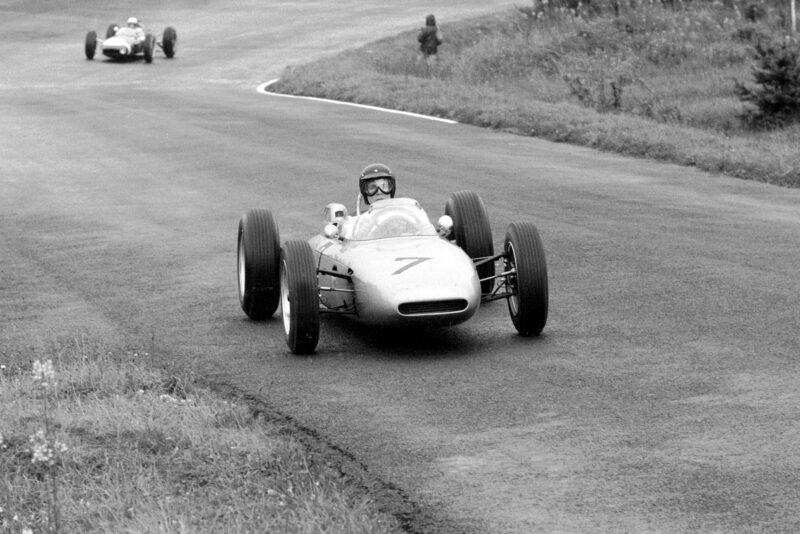
Gurney found himself very much in tune with his Porsche, taking pole
Motorsport Images
While all this activity was going on and getting more and more intense there occurred an accident that was entirely unnecessary and one that has been on the cards for a long time. Porsche had allowed a German Television firm to fix a large camera to the rear of de Beaufort’s Porsche in order to get “speed shots” round the circuit.
They did this last year on the Lotus driven by Moss and the results were quite hopeless, and did not justify permitting this to take place while practice was going on. Graham Hill was out in the latest BRM and unknown to him was not far behind de Beaufort, while behind the BRM were McLaren and Maggs in the Coopers, but all out of sight of each other. Going down the steep descent into Fuchsrohre the camera mounting broke and the large TV camera fell off the back of de Beaufort’s Porsche, he not realising it immediately.
Soon afterwards Graham Hill came charging down the hill at 140mph, through the gentle ess-bend, to find this large object lying in the road. There was no possible hope of avoiding it and as the BRM ran over it the oil radiator and pipes were ripped off and the oil poured out onto the road and the car’s rear tyres, and Hill found himself spinning through the bushes and trees. By a miracle the car stayed upright, even though the right-hand rear wheel and suspension was ripped off, and with a crashing of undergrowth the car came to rest, with Graham shaken and bruised.
While this was happening McLaren was at the top of the hill, but seeing the dust and general disturbance down in the forest he came down the hill gently, across the oil patch and stopped on seeing the BRM in the bushes. At this point Graham Hill climbed out and signalled that he was all right, so McLaren motored off, not realising what had caused the accident. Before any marshals or flag men had appeared, Maggs approached the top of the hill, and by this time all the dust and foliage had settled and everything looked normal, so he dived down the descent unsuspectingly. At full speed he hit the oil and next moment was spinning wildly, bouncing off hedges and trees but luckily finishing up against the safety fence and some thick bushes. Like Hill, he was shaken but unhurt, but the Cooper was bent in all directions, though nothing had broken off.
For the sake of getting a few feet of bad film, two drivers’ lives had been risked and two cars demolished, but the all-powerful Television racket seems able to get away with such things. When everyone got back to the pits and the various stories were pieced together there was a right old shin-dig and practice ended in a bit of a shambles one way and another.
On Saturday morning practice was 15 minutes late in starting and by that time rain had approached, which completely upset an interesting little plan schemed up by Colin Chapman and Jim Clark. Practice usually begins with everyone lined up at the pits ready to go; then they dash off in a bunch round the South Turn, back through the gate and set off on a timed lap, so that the first few laps are pretty crowded until the field spreads out, by which time corners can get marked with rubber or oil.
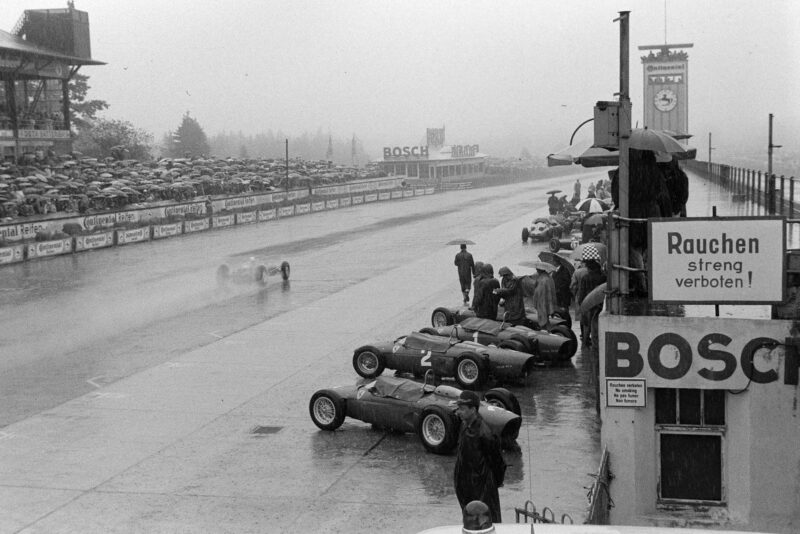
Qualifying and the race was poor conditions
motorsport Images
While everyone was going round the ‘starting circuit’ Jim Clark shot off round the full circuit, which meant that his first lap would not be timed by the official timekeepers, but Chapman was timing him from behind the pits. The point of this was that the whole circuit was entirely clear and Clark could have a real go knowing that he would not have to lap anyone, or find any oil spilt anywhere. In theory this was to be the lap to end all laps, in fact the one I’ve been waiting to see for a long while.
Unfortunately the organisation held up the start of practice and by the time Clark set off the rain had begun to fall, but even so he carried out his plan and got round in 9min 13sec by Lotus timing on the wet track. This more than satisfied them as it meant they knew that the combination of Clark and the Lotus 25 could cope adequately with the wet track, but what a pity practice did not start at 11:30am, as scheduled, for then Clark would have had it dry and cool all the way round.
Everyone else went splashing round the circuit, but with the gentle drizzling rain there was no hope of going fast, and as a session to sort out the starting grid Saturday morning was a complete waste of time. Each driver had to do five laps in order to qualify and both Taylor and Brabham had their work cut out to get them all in during this final session. Taylor’s car had been fitted with the spare engine, while Brabham’s car had an engine built over-night from the remains of his and Taylor’s wrecked engines. Taylor did his laps in a very unhappy state as the engine was running badly, having not been looked at since it won at Aintree, while Brabham did his five laps very carefully as the engine was sealed up with Mr Holt’s Wondarweld.
He did five slow laps and then started on his sixth a bit quicker, only to run out of petrol halfway round! In desperation Phil Hill made a slightly faster time in the wet than the previous day in the dry, but all the Ferraris were hopeless and Rodriguez had made the fastest lap the previous afternoon in 9min 14.2sec, which was very quick considering the car and general set-up, but was not as quick as de Beaufort, who had done a splendid 9min 12.9sec.
Maggs was using the spare Cooper with 4-cylinder engine, so his time in the wet was the one that counted for the starting grid. BRM were back on their regular two cars once more, it seemingly being impossible for them to keep three cars for very long. Among the private owners there was any amount of activity, for Walter tried the Lotus-BRM, Lewis completed his five laps safely, but Seidel was trying to keep his gearbox together with glue and it did not work. Keith Greene was quite happy with his Gilby-BRM for the first time out at a race meeting, though naturally it was still being sorted-out.
When practice was over the sun came out and the track dried up, and after lunch Hermann Lang did a lap of the circuit in a 1939 Mercedes-Benz Grand Prix car, with 3-litre engine with two-stage supercharging, running on nitro-benzine fuel mixture, making fine noises and smells. At the end of the lap it went by the grandstands and pits at a speed which made a lot of people jump backwards and say “Oh!” Naturally such a car has nothing in the way of brakes, tyres or road-holding compared with modern Grand Prix cars, but it certainly had an engine, and that V12-cylinder power unit in a chassis designed by Colin Chapman would make quite a good racing car.
Although practice was finished work was not, and mechanics and team managers set to and prepared for the race, while the drivers got together at a Grand Prix Drivers’ Association meeting, to discuss their troubles, and television cameras no doubt. The Brabham had its “hack” engine removed in readiness for fitting a new one that was due to arrive on Saturday night, while the Ferrari team looked at their new lightweight car and realised there was still a lot of work to do to it. During the night the rain began to fall in earnest, and on Sunday morning it was still raining, and it went on raining and raining nearly all day.
Race
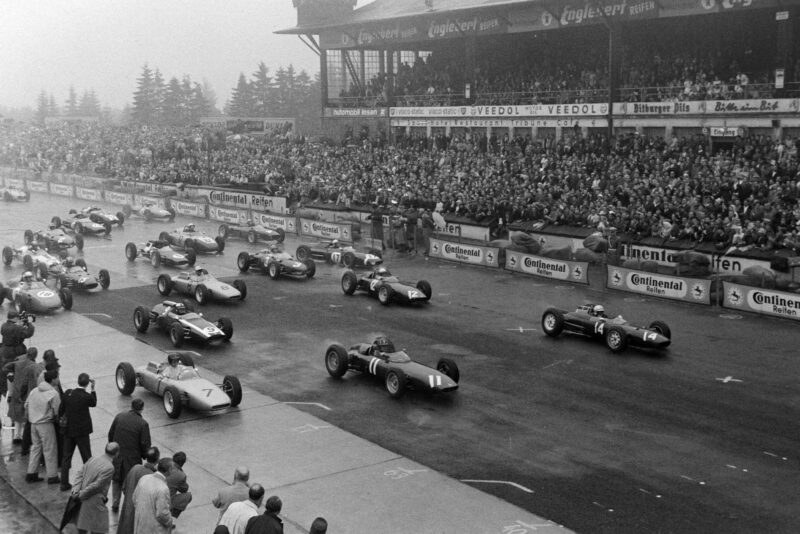
The field pull tentatively away from the grid
Motorsport Images
Activity on Sunday started at midday with a 6-lap GT race, by which time vast crowds had arrived, in spite of the weather, for with Gurney and the Porsche on pole position on the grid there was every chance of a German victory. The race was due to start at 2pm, over a distance of 342 kilometres, or 15 laps, but as preparations were made and cars came out to the pits the heavens opened and a solid wall of water came down that prevented anything happening at all.
The start was officially postponed, and it was approaching 3pm before any hope of getting under way became possible. Most of the cars went round and round the “starting circuit” to get the feel of things, and then they were allowed to go a full lap of the circuit to view the conditions, for many of the dips had flooded and earth banks had been washed into the road.
However, gangs of workers cleared the track but it was still terribly slippery, so that this reconnaissance lap was a wise precaution. Returning to the pits tanks were topped up again, even though some of the marshals tried to prevent this happening for some strange reason, and finally a wet and dripping starting grid was assembled.
Chamberlain, Shelly and Seidel were ruled out as not having done sufficient practice, and for a time Trevor Taylor was also out, as the timekeepers had him down for only four laps, but Chapman convinced them he had clone five, so he was allowed to start, but put on the back of the grid. The Brabham team had completed the installation of the new V8 Climax engine, and Surtees elected to drive the old Lola-Climax V8, while the Ferrari team kept to the same cars as used in practice.
It was 3:15pm before the start was given and the rain was still falling gently and drivers tried to keep themselves and their equipment dry as long as possible. Clark was so busy trying to stop his goggles from steaming up that he forgot to switch on his fuel pumps after he had started the engine, and just as the flag fell his engine coughed and died with dry carburetters, and everyone else surged away around him, leaving him furiously waiting for the float chambers to fill again, having realised his error. He was last away and it was Gurney leading Graham Hill and Surtees up the back straight, though Phil Hill was well placed, having made a splendid start from row four, passing a lot of people on the outside as they got away.
“Clark was so busy trying to stop his goggles from steaming up that he forgot to switch on his fuel pump”
The whole field of 26 starters streamed away round the circuit, with Gurney and the silver Porsche all the while in the lead, which must have cheered the hearts of the 360,000 wet and cold people around the numerous vantage points. Taylor was still having a bad time, his engine not running at all smoothly arid often not on all eight cylinders, and he was a little over halfway round the first lap, rounding a bend, with the engine spluttering when it suddenly cut-in on all eight and the sudden power shot him straight off the road and through the bushes, bending the front on a tree.
He was not alone in trouble for a little farther on Trintignant suffered a broken selector in his gearbox, it being a brand new selector fork fitted that morning as wear had developed in the old ones. This was an exact repetition of Ireland’s trouble on the start at Aintree. Some idea of the conditions on this opening lap can be gauged by the leader’s time of 10min 42.9sec, and Gurney was very closely followed by Graham Hill (BRM), Phil Hill (Ferrari), Surtees (Lola), Bonnier (Porsche), McLaren (Cooper) and Rodriguez (Ferrari), all these being more or less nose to tail as they streamed past the pits. After a gap came Ginther (BRM) on his own and then another gap, with Brabham (Brabham) leading the rest of the runners, all that is except Taylor and Trintignant, while Collomb stopped at the pits from the very end of the field.
All the way round the second lap Graham Hill was pressing Gurney, but he could not get by, and the road was so slippery and unpredictable that it would have been asking for trouble to try any pushing tactics. After muffing his start Clark had passed 17 cars on the opening lap, which must have involved taking a lot of chances, and he finished the first lap just behind Brabham, passing him and closing on Ginther during the second lap. Gurney and Graham Hill were side by side as they came comparatively gently over the brow from the Tiergarten uphill swerves, and Hill’s time for the lap was 10min 21.8sec, which is a Porsche Carrera time in the dry, which gives some idea of how difficult the conditions were.
The two cars disappeared down to the South Turn in very close company, and as they came up behind the pits the BRM was leading, much to the joy of the British but not the Germans, who went very quiet. Behind these two the situation had changed considerably, for Surtees now had the Lola behind them, while there was a-small gap before McLaren came by with Bonnier, Phil Hill and Rodriguez right with him. Trintignant had limped to the pits and the Walker mechanics removed the broken selector and jammed the gearbox in 3rd gear, and the unhappy Frenchman limped off again to try and complete the minimum number of laps to qualify for Starting money.
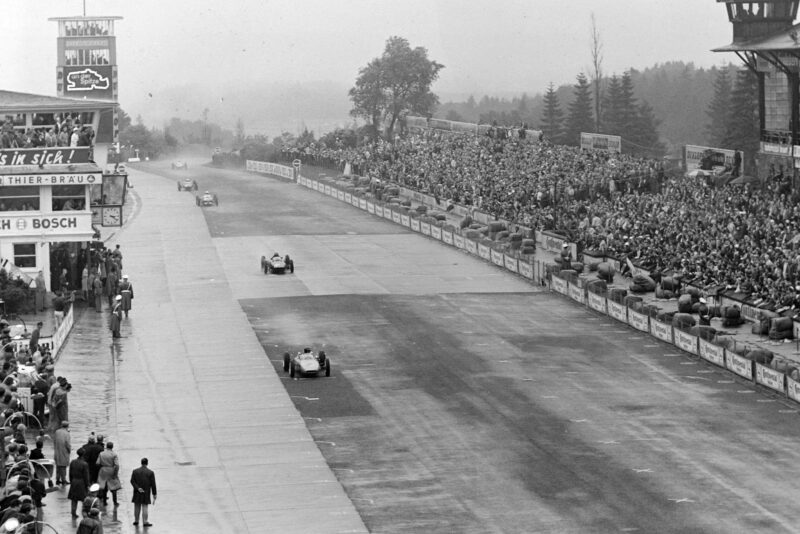
Hill follows Gurney, getting by on lap 3
Motorsport Images
Having got by Gurney it seemed that Graham Hill might have got away, but Gurney thought-differently, and Surtees was right behind them; in addition, Graham Hill was being troubled by his fire-extinguisher, which had fallen out of its clip and was rolling about the cockpit floor, bumping his heel every time he put the brakes on, and there was no time to reach down and put it back in place. On lap three the three leaders got well away from the rest, and McLaren in fourth place left the others so that Bonnier was engaged in a dice and carve-up with Phil Hill and Rodriguez, and Clark was now closing on them, having quickly disposed of Ginther.
This made the Lotus 25 in eighth place after its bad start, which was a fantastic pace, considering the very wet track. While it was raining steadily on the high plateau of the start area, it stopped on other parts of the circuit, or rained even harder, and it was these inconsistent conditions that made the going so difficult, especially in the wooded parts.
“Clark’s Lotus 25 was in eighth place after its bad start, which was a fantastic pace, considering the very wet track”
At the end of the fourth lap, which was the point at which all those still running qualified for their starting money, the pits became surprisingly busy after the leaders had gone by, Graham Hill, Gurney and Suttees still being in a tight bunch. McLaren was well and truly on his own, but Clark was now between the two Ferraris of Rodriguez and Phil Hill, and in getting amongst them he had displaced Bonnier, who had dropped some way back.
Bandini in the new Ferrari was not going at all well, and was back in the field being pressed by Maggs and Baghetti and on the fourth lap he went off the road at the Karussel and bent the nose and damaged the radiator, so that though he got going again it was only to get to the pits, where he retired. Salvadori had also stopped at the pits, from 21st position, to retire with gearbox trouble, and Schiller came in to retire with the Swiss-owned Lotus-BRM as the oil pressure was sagging, and after a long while Trintignant completed his fourth lap and gave up.
Graham Hill had done his third lap in 10min 12.2sec, and this was to be the fastest of the race, even though the leaders were still trying hard, as they were lapping at more than 1min and 20 sec slower than they would have been doing in the dry. During lap five Gurney had his battery come loose in its holder and while reaching down to refix it he ran wide on one corner and this allowed Surtees to slip by into second place, and seeing Gurney apparently slow down he thought the Porsche had blown-up.
Clark was now away from the Ferraris and at the end of the lap Phil Hill stopped to change his vizor, which dropped him back behind Bonnier. Near the end of the now depleted field Burgess was battling with de Beaufort, but Brabham was leading the private-owners and Maggs was leading the 4-cylinder cars, driving very well to keep ahead of Baghetti, and at the same time he was closing on Brabham.
At the end of lap six it looked as though everyone had settled down for Graham Hill was 3sec in front of Surtees, who was 7sec in front of Gurney, and 17sec passed before McLaren came by, with a further 7sec between him and Clark, the Lotus 25 still pressing on furiously and gaining on everybody, Graham Hill included. This apparent easing-off was only temporary, for during the next lap the leading three all got to grips again, and were nose to tail once more, not that Graham Hill wished it that way, but Surtees and Gurney would not give up and settle for second and third places.
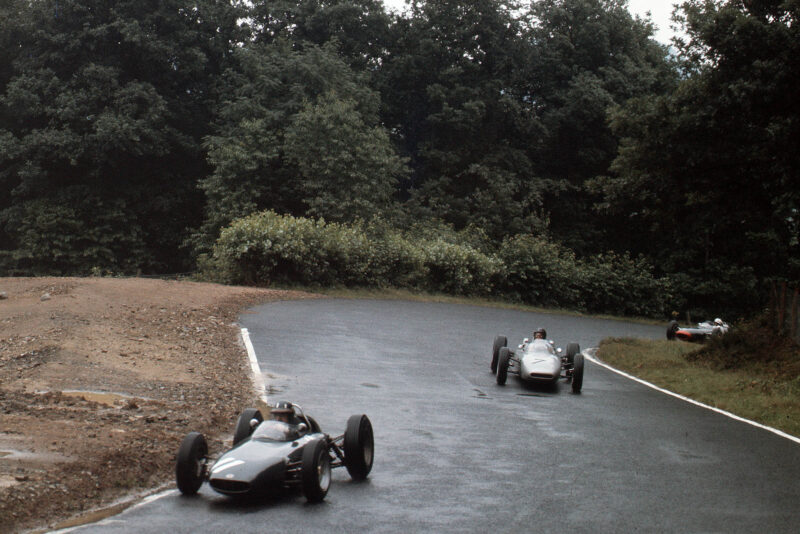
Gurney and Surtees keep the pressure on Hill
Motorsport Images
It was still raining steadily and Graham Hill was having a hard time concentrating, being unable to make the slightest error of judgement for the other two were pressing all the time. Clark was now all set to take McLaren and further back Maggs had disposed of Brabham and was about to pass Phil Hill. With the slippery and treacherous conditions, the drivers of the 4-cylinder cars, with their lack of power were having a much easier time than those with 8-cylinder engines, for there was less chance of getting in difficulties when the power was turned on and Maggs, Burgess and de Beaufort were all having a good go, worrying much faster cars in the process.
The Gilby-BRM V8 had been running quite well until nearly half-distance when a bracket on the chassis locating the gearchange rod between lever and box tore away. Greene stopped at his pit and his mechanics made a temporary repair and away he went again, but he had not gone far before the right front lower wishbone mounting broke and he came to rest with the wheel leaning drunkenly. Although the car was just about drivable he wisely stayed where he was until the race was over, limping back to the pits after everyone had stopped racing.
“If the Scotsman wanted to drive that fast in the wet then good luck to him”
Lap eight saw Clark get past McLaren and away from him, the Cooper driver thinking that if the Scotsman wanted to drive that fast in the wet then good luck to him and let him get on with it, for Clark was still gaining five or more seconds a lap on the leaders, and with seven still to go he was surely going to be up with them before the end. Maggs passed Phil Hill at about this time, for the Ferrari had used up its rear shock-absorbers and was handling appallingly, having been perfect for the first few laps.
After nine laps the leading BRM had the Lola right with it still, and the Porsche was only a very short distance away in third place, while the Lotus 25 was now only 17sec behind the leader and still gaining rapidly. Being unable to Cope with Maggs and the 4-cylinder Cooper, Phil Hill gave up at the pits in disgust, but Baghetti who was being harried by Burgess and de Beaufort, struggled on gamely. Brabham was overdue and arrived at the pits slowly with broken throttle linkage and retired after an unhappy debut with his new car.
On some corners the leading trio would be almost touching each other, and in places they would spread out, but never by much and after 10 laps they were as close as they had been on the fourth lap, but Clark was now down to 14sec from them, his driving in the wet being almost unbearable to watch. Time and again he was in almost uncontrollable slides on the wet and slippery surface, but always he was the master of the situation, until on his eleventh lap when he got into two really big slides while in 5th gear, and he was lucky to get away with them. Until this point he had been driving in one of those inspired trances that are brought on by being niggly with oneself, but after nearly losing the car completely at very high speed he came to a more reasonable sense of proportion and decided to ease off and settle for a very firm and well-won fourth place.
When trying absurdly hard there often comes a point when a driver knows he has chanced his luck far enough, and this point had come to Jimmy Clark so it was no disgrace to ease off and let the leaders go. Baghetti came by the pits without Burgess on his tail and then de Beaufort went by signalling that the Cooper had spun; Burgess got going again but had lost a lot of ground. After trailing miserably along near the end Lewis gave up after 10 laps with ineffective front shock-absorbers. Next time past the pits de Beaufort was right alongside Baghetti’s Ferrari and the Dutchman was so overjoyed that he foolishly went by the red car on braking for the South Turn. Of course, he did not make it and spun wildly, letting Baghetti go on, smiling quietly to himself. This spin dropped de Beaufort a long way back, so that Burgess once more took up the chase of Baghetti.
The position of the first three cars seemed firmly fixed, for though they were still in close company there seemed no opportunity to do any passing, and the slippery road made it impossible to do anything dicey in the way of pushing and shoving, or outbraking each other. It was just a question of keeping at it, with Surtees hoping Graham Hill would make a mistake, and Gurney hoping they would both make a mistake. The strain was beginning to tell on Hill, and he found himself hoping that he would make a mistake and spin off into the fields away from it all, but nobody can make a deliberate mistake and he went on driving brilliantly and keeping ahead of the other two, but he really wished they would give up and settle for second and third.
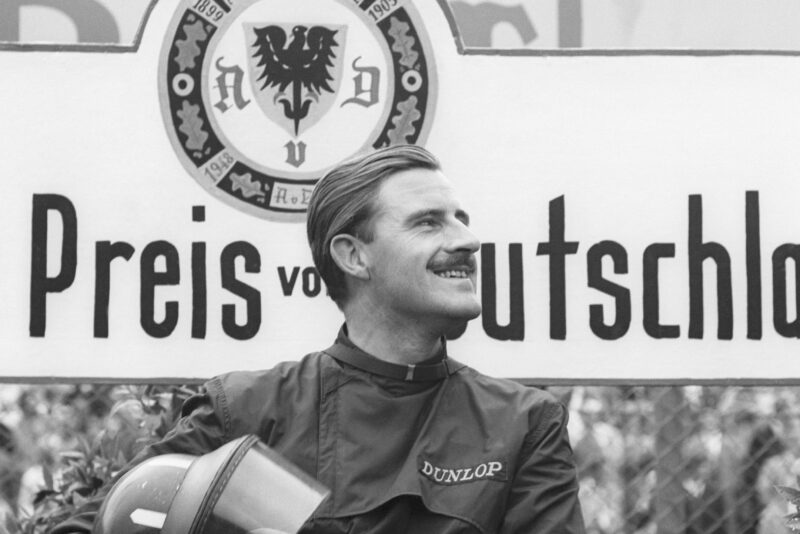
Hill won out in a tight battle to top the podium
Motorsport Images
Clark was now firmly in fourth place, and dropping back slightly each lap, much to Colin Chapman’s relief for he is getting short of Grand Prix cars. As the leaders started their last lap they were close together once more and Suttees on occasions actually had the Lola’s front wheels alongside the BRMs back wheels, but always something arrived to prevent him getting any nearer the front; either it was an approaching corner, a change of direction or change of conditions, or a car they were lapping, and the three of them completed the last lap as close together as they had been at the start.
An exhausted but triumphant Graham Hill crossed the line after more than 2½ hours of very wet driving, with Surtees and Gurney right behind him, only 4.4sec covering the three cars. Then came Clark in fourth place, followed by McLaren who had just kept himself ahead of a pressing Rodriguez, who had driven a spirited race with an old car. The rest tailed in one by one except that Burgess followed Baghetti in very closely, having actually got past him on the last lap, but the superior speed of the Italian car told on the final straight towards the Tiergarten corners, and Baghetti retook the advantage.
The long and very arduous race was over at last, and the rain was still drizzling down and the whole of the Eifel mountains was a soggy mess. While the Grand Prix field dried itself off and gathered up its cars a five lap race was run for saloon cars, by the end of which it was almost dark and clouds were obscuring everything. The Nürburgring can be marvellous, and it can be “bloody”— on the night of August 5th it was just that.
Nürburgring natters
The Nürburgring is not Brabham’s luckiest circuit. Last year he made a poor debut with the first Climax V8 engine, this year he had a similar poor race with the Brabham on its debut.
To this writer, television has always been a rude word; now it’s a rude word to most people in Grand Prix racing, especially BRM and Cooper.
The results of the German Grand Prix stand close scrutiny, with six different makes in the first six places and three different 8-cylinder engines in the first three.
The colour scheme of the new Brabham must have been chosen by one of those “nice young men” described as interior decorators.
For the first time in my memory at any race the Press department produced a complete and official lap chart after the race. Congratulations AvD.
Results : XXIV GERMAN GRAND PRIX
Formula One—Nurburgring 15 Laps—342 Kilometres—Very Wet
Retired : T. Taylor (Lotus-Climax V8), lap , accident ; L Bandini (Ferrari V6), lap 4, accident: F.B. Collomb (Cooper-Climax 4-cyl.), lap 3, gearbox ; R. Salvadori (Lola-Climax V8), lap 4, gearbox; H. Schiller (Lotus-B.R.M. V8), lap 4, oil pressure; M. Trintignant (Lotus-Climax V8), lap 4, gearbox: K. Greene (Gilby-B.R.M. V8), lap 8, broken front suspension: P. Hill (Ferrari V6), lap 9, rear shock-absorbers; J. Brabham (Brabham-Climax V8) lap 9, throttle linkage; J. Lewis (Cooper-Climax 4-cyl.), lap to, front shock absorbers.
26 starters — 16 finishers
